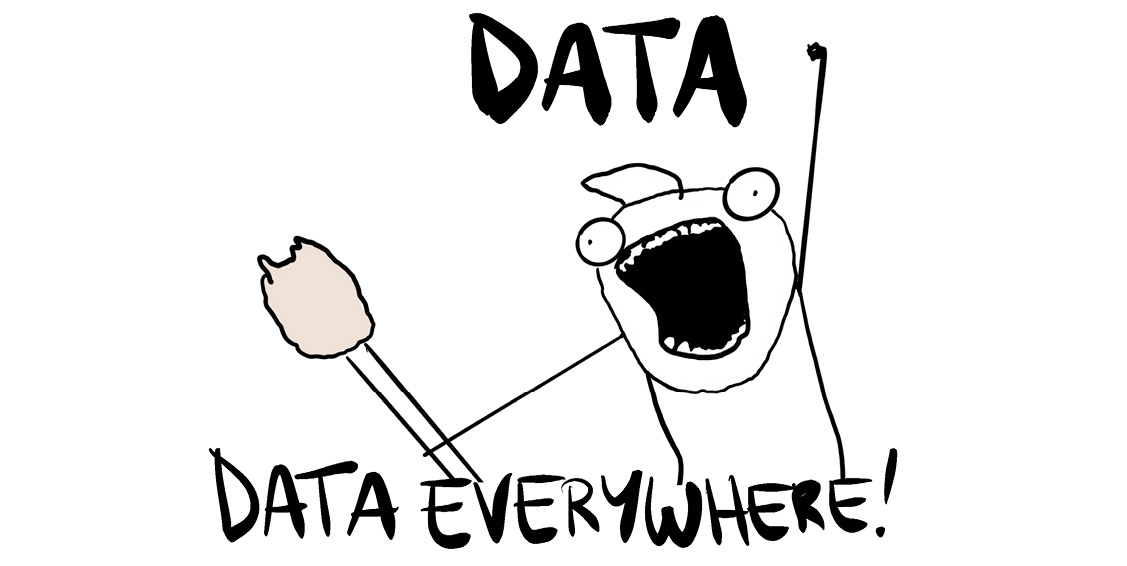Understanding how much data we produce
In this section, we will dive into a little bit of computer science, learning about digital data measuring units, but we will also talk about a curious subject. I'm talking about the data we produce every 60 seconds: it is unbelievable! So, first of all, let's talk about measuring units.
One byte consists of 8 bits, and since computers deal with ones and zeros, which means that they deal with math of base two instead of decimals (math of base ten), all increments in data storage units have to equate to the power of two, rather than the power of ten, like we all are used to. Consequently, one kilobyte (KB) consists of 1,024 bytes or 210, and not 103 as you probably expected.
Now, let's see some real-world examples:
- 1 hour of social network page scrolling will consume around 120 MB of data.
- 1 hour of streaming music will consume about 150 MB of data.
- 1 hour of watching full HD YouTube videos will consume approximately 1,500 MB (or 1.5 GB) of data.
- 1 hour of high-definition streaming on Netflix will consume more or less 3,000 MB (or 3 GB) of data.
- 1 hour of Skype calls with five or six colleagues will consume up to 4,000 MB (or 4 GB) of data.
Another example is that the entire original Super Mario Bros game consists of 32 KB, which is roughly 0.03 MB! There is an unbalanced proportion between the game's size, which is incredibly small, and the amount of happiness it brought people of any age from all over the world!
Now that we've got some understanding of the measuring units, let's talk about something more fun: data exchanges of the online services we all use, every day. We will also build, later on, a few Power BI charts using the data I am going to show you right now. We will create those charts to get some familiarity with this powerful business intelligence tool and discover some of its basic commands and features.
Have you ever wondered how much data we generate every 60 seconds?
The amount of data we generate is insane. Think, for example, of a quite simple thing that we do over and over every day: Google searches. We even invented a new verb for it, "googling"! It has also become synonymous with the internet. Anyway, we all are curious about everything all the time. People like me and you are always thirsty for information, and that's why we use Google all day long. The famous search engine is so dominant in the search engine market because it provides free access to information in a blink of an eye. But, of course, Google didn't become a giant overnight. Back in the days before Google or Facebook, the absolute king of the internet was named Yahoo, a tech company founded in 1994 that, today, still, handles 5% of web searches. A few years later, in 1999, the company was worth $125 billion, but unfortunately, the giant made some wrong moves and started to lose users. Probably the most significant wrong move was to refuse to acquire Google. Yes, in case you didn't know, Google's Larry Page and Sergey Brin approached the Yahoo CEO in 1998 and asked for the small amount of $1 million. You can deduce the end of the story; **Yahoo refused. But this wasn't the only mistake made by Yahoo. Yahoo declined to buy Google again in 2002 for an amount of $5 billion, and in 2008 refused to be acquired by Microsoft for $44.6 billion, but that is another story. Anyhow, Google today has passed $1 trillion in market value, which is astonishing.
Back to the data! At Google, nowadays, they process something like 5.4 billion searches per day! Breaking it down, you get 3.8 million searches per minute. Insane. The giant search engine now dominates the market with almost 93% of total internet searches.
But this is not the only crazy number of online services we are going to talk about. You might be wondering about LinkedIn, Amazon, Netflix, YouTube, Instagram, and so on. Earlier, I told you that we would be talking about what happens every 60 seconds. Well, if you go back a few lines, you'll see a sign with two asterisks right next to the phrase **Yahoo refused. I counted how long it takes to read the text from the "**Yahoo refused." to now, and guess what, it takes more or less 60 seconds to read those lines!
Here, I have listed a few things that happened in that timeframe:
- Amazon shipped between 6,000 and 7,000 packages.
- Users scrolled more or less 350,000 times on Instagram.
- 55,000 users, approximately, logged on to Microsoft Teams.
- Netflix users streamed about 100,000 hours of video.
- 2,000 new Reddit comments were created.
- LinkedIn gained 120 new professionals.
- 4,500,000 videos were watched on YouTube.

Figure 1.8 – Data everywhere!
These are just a few of the things that happen every 60 seconds on the internet, and even if it seems overwhelming, we, as humankind, just started the ladder of digitization. During the last 10 to 20 years, thanks to the spread of the internet, we saw a rapid evolution of the business landscape. In this short period, the digitization era has left us with a very eventful time.
In the next section, we will talk about a less technical yet quite interesting subject: hybrid jobs!

































































